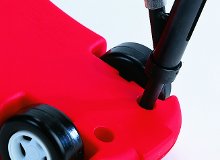|
|
Home » Case-studies » Toy Manufacturing Trends
Toy Manufacturing Trends What are the biggest assembly/joining challenge affecting toy manufacturers today? The biggest assembly challenge affecting toy manufacturers today is cost vs. assembly method. Toys are typically lower cost products, and must be assembled efficiently for the least amount of labor and cost. What types of joining processes and equipment are toy manufacturers looking for today? Toy manufacturers are using mechanical fit (interlocking parts), adhesives, and screws to fasten toys together. Plastic welding is also used in certain types of designs. What are the advantages of using screws for toy assembly? Screws offer several advantages for toy assembly. The most obvious advantage to using screws is ease of disassembly in the case of a defect or mistake in the assembly process. Other joining processes such as adhesives, plastic welding, or interlocking fits are much more difficult to disassemble in the event of a defect, leading to higher scrap rates. Screw fasteners also enhance the use of automated equipment in the assembly process. Design Tool Inc. offers both handheld auto feed screwdriving systems or full CNC screwdriving equipment to assemble the product. DTI also offers auto feed components such as bowl feeders and platen assemblies that can be used by machine builders to build custom assembly equipment for the toy industry. The use of screws also contributes to a more robust design, as the fastening process can be controlled and quantified, confirming joint integrity without destructive testing. DC electric screwdrivers can be used for reporting torque and angle configurations. What types of toys typically rely most heavily on screwdriving? Toys with electrical or mechanical motion components tend to rely most heavily upon screws to fasten the components. As design complexity increases, the use of screws seems to increase also. What types of screws tend to be the most popular with toy manufacturers? Self-tapping screw designs such as Plastite thread forms tend to be the most popular with toy manufacturers. What types of screwdriving tools are the most widely used for toy assembly applications? In terms of automation, hand held auto feed screwdriving systems are the most widely used for toy assembly applications. Robotic systems and XY Cartesian systems are used less frequently due to the higher initial cost of these types of systems. Are plastic parts used in the toy industry becoming more complex today (e.g., shapes and sizes)? Can you give me any generic examples? What challenges does this put on assembly? As the use of CAD software has become more prevalent throughout the toy industry, the shapes of the plastic parts have become more complex. For example, toys that transform from one shape to another by moving components into different positions have very complex shapes. As parts become more complex, access to the fasteners themselves becomes more challenging. A fastener may be located in an area that has minimal clearance around the head of the screw, making automation very difficult. Also, fasteners are often located in deep recesses that limit screw access as well. Is screw sizes used in toys becoming smaller today? How is that affecting assembly? Screw sizes used in toys are becoming smaller today, as joint analysis and cost drive the manufacturer toward using the smallest fastener that will achieve the desired joint integrity. Smaller screws are often more difficult to automate, as the clearance area around smaller screws is usually more restrictive, leading to problems with access on automated systems. Smaller screws can also be more difficult to feed as well. Design Tool, Inc. has a patented feed mechanism that works very well with small screw designs. 
|
